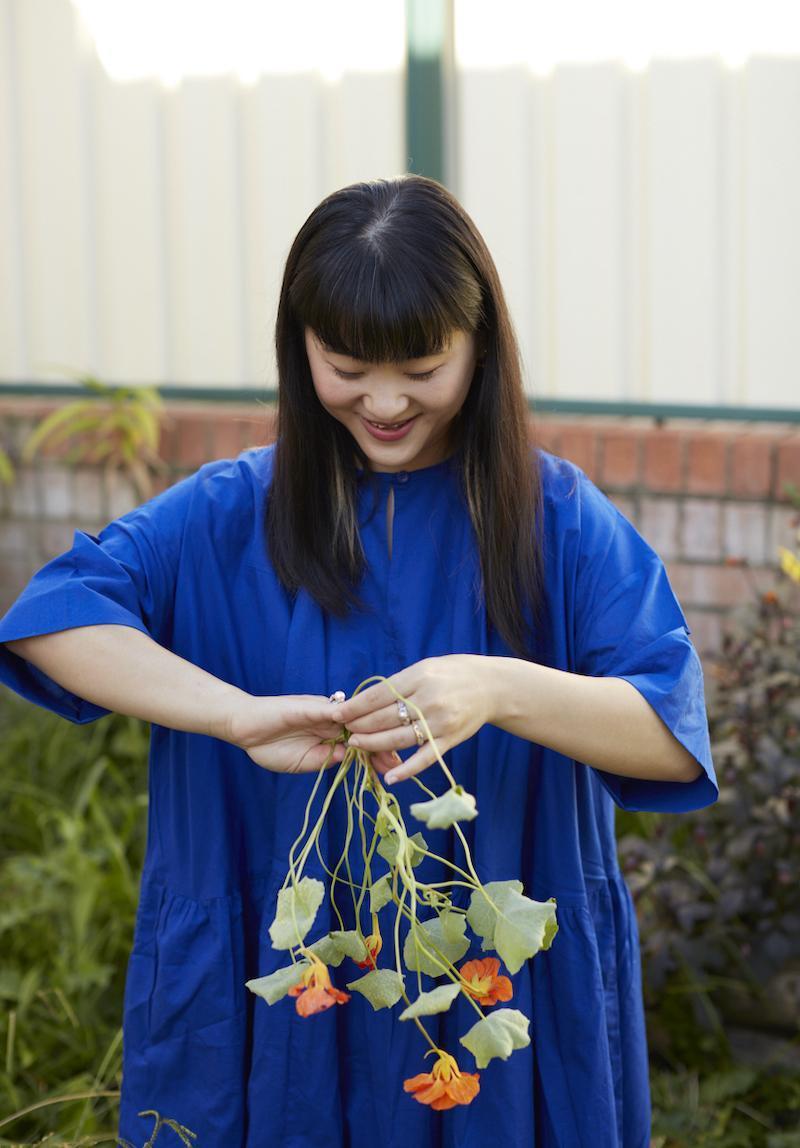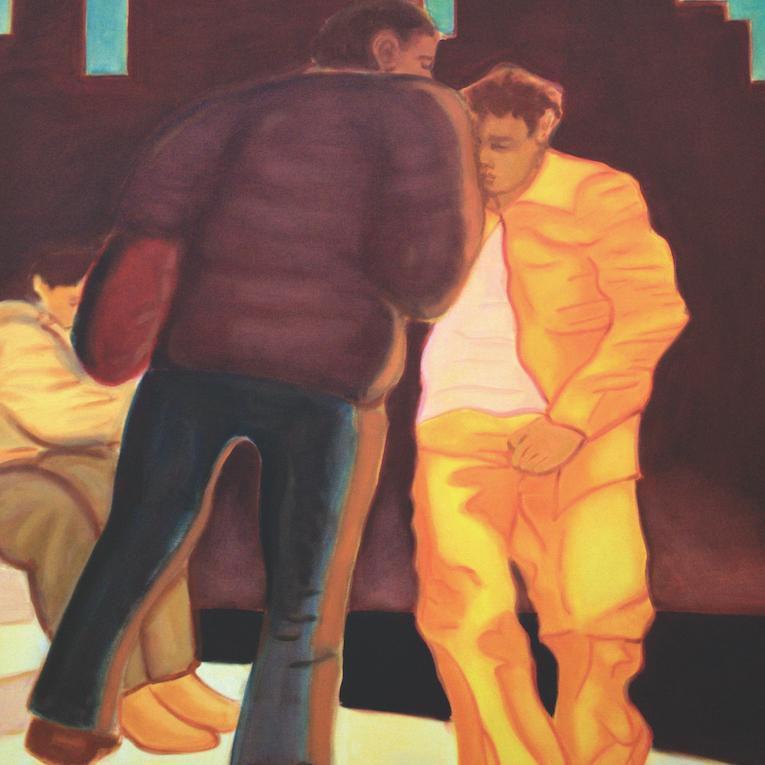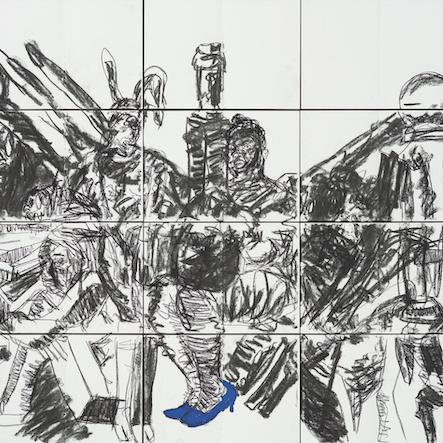Necessary Evil
Like dazzling portals into a candy-filled Hell, the new works of Louise Zhang fight their own construction as they attempt to unpack the artist’s Chinese-Australian identity.
Words: Victoria Hynes
Photography: Zan Wimberly
Over the past decade, Sydney-based painter, sculptor and installation artist Louise Zhang has developed a practice that has been described as the monstrous cute. Her paintings and sculptures are a playful, but at times grotesque blend of Western kitsch, “schlock” horror cinema, pulp fiction and traditional Chinese iconography.
Glimpsed across a screen during a FaceTime chat with Zhang, her dreamy paintings practically pop with colour. Floating across surfaces awash in a lemon sherbet and pastel pink palette are cherry red moons and cerulean blue clouds. The centre of her studio features a strange amorphous sculpture moulded from foam clay. In tones of fleshy salmon, it appears like a solidified flame ball. All make one curious and curiouser to see the work in situ for Zhang’s forthcoming exhibition at Artereal Gallery, Sydney in July titled Like an infertile python egg, we are trying, her fourth solo show with the gallery.
Her sculptures are usually based on the Chinese Gongshi, or Scholar Rocks – primordial forms worn and weathered by natural elements – which Chinese scholars viewed as holy mountains and meditated upon as symbols of transformation. Zhang recreates these traditionally male objects and paints them in a candy pink and fairy floss palette, thereby contemporising and feminising them. The colours draw you in, while the slimy and viscous textures are often visually repellent. In her paintings, body parts or flesh can be spotted, painted in synthetic sugary tones to make them more palatable to the eye.
“We have so many tools to work with as artists,” says Zhang, “but I think colour is one of the most powerful tools. It’s the first thing you see, the impact of colour… it has this ability to either repulse you or attract you. I particularly like these synthetic colours, these really bright ones, because it reminds me almost of marketing, where it’s really in your face [and] you are attracted to it, but then from there you actually get the message.”
Zhang’s art practice tends to present us with dichotomies and contradictions – Eastern motifs and Western pop styles, dark themes presented in a joyful palette. Over the past year, the artist has experienced her own extremes of highs and lows. Working under lockdown and dealing with chronic pain, she also was made uncomfortably aware of the anti-Asian sentiments that had been circulating in Australia since Covid-19 took hold.
Fortunately for the Chinese-Australian artist, this was counterbalanced by a whirlwind of success in the corporate and public sector. In 2020-21, Zhang held a small survey show at the National Gallery of Victoria, Melbourne with a work purchased for its contemporary collection. The project was sponsored by MECCA, Australian cosmetic and beauty brand giant, which also featured the artist’s designs in a limited-edition campaign of packaging
throughout its Australian stores. For Zhang, this project was a means of making her art more accessible.
“Most people don’t have thousands of dollars for an artwork,” she says. “So a lot of people ended up keeping the packaging and some of them put the tissue paper print in a frame or cut out the painting from the gift bags… Some people even turned it into necklaces and book- marks. This is how art should be. I’m so happy about that aspect of accessibility.”
Zhang’s unique symbolism and imagery has developed over years of research. She graduated from UNSW Art & Design in 2016 with an Honours and Masters degree in Fine Arts. Growing up in Western Sydney as a daughter of Chinese migrants in the 1990s, Zhang was a self-confessed teenage Emo and consciously rejected her Chinese identity. It was only years later, as a freshly minted art school graduate that she engaged in two residencies in China, first in Beijing in 2016 and the following year in Chongqing, that she became fascinated with traditional Chinese mythology.
Her current series of works focus more on Chinese compositions than Western imagery. Her large-scale paintings feature chrysanthemums, peonies and lotus flowers – Chinese symbols of purity. However, look closer and the faces of viscous beasts, jagged claws and hellish flames start to emerge from the background. Zhang explains that these symbols come from Chinese folklore, particularly its version of hell, known as Diyu. Although brought up as a Christian, she became fascinated by the Eighteen Levels of Hell in Chinese mythology, each with its own form of punishment and atonement.
“I find looking at this dark stuff quite joyous because it’s me learning, it’s me discovering,” she says. Spooky symbols from these Hell realms are offset by her love of Nianhua or Chinese New Year, with its popular depictions of cherubic babies, golden fish and peach blossoms, denoting abundance and longevity. Zhang’s appreciation for Chinese New Year led to the City of Sydney commissioning her to create public sculptures for its Chinatown New Year celebrations – Monkey Tower in the Sydney Opera House forecourt in 2019 and a series of Lunar New Year Moon Gates in 2020.
The artist often installs circular three-dimensional Moon gates in her exhibition spaces, taken from Chinese garden design, but with her new show she has instead framed her paintings in red powder coated lattice windows, which act as portals into her dream- like worlds. Zhang’s visual iconography – both fantastical and macabre – is a means of personal catharsis, while the dichotomies in her work reveal her explorations in uncovering her hybrid identity as a Chinese-Australian artist. Yet, at the end of the day Zhang wants her artworks to be viewed as a joyful experience.
SOPHIA CAI
Curator and writer
“I first remember seeing Louise Zhang’s works on the website Tumblr, back in 2011 if not earlier. I have been following her work since. At first I was drawn to Zhang’s works because of their visual aesthetic, but quickly I learnt to look deeper into the imagery and iconography behind the work. There are levels and layers of interpretations possible with Zhang’s works – which makes their practice compelling
to a range of audiences. Her works offer a fresh contemporary perspective on myths and relics from the past; combining her lived experience as an Asian-Australian woman with her love for horror and fantasy to create a wholly unique visual language. Zhang’s works speak to her own experience as a third culture kid, but they have broader relevance as a reflection on how cultural ideas and values are transmitted.”
RHIANNA MELHEM
Associate director, Artereal Gallery, Sydney
“Artereal Gallery has represented Louise Zhang since 2014. One of the factors that initially drew me to Zhang’s fascinating works was the way in which they mash together references as diverse as horror films and Chinese mythology. I also really respond to the seductive relationship between attraction and repulsion which is key in her practice.
Zhang’s work is currently included in the 2022 Sulman Prize at the Art Gallery of New South Wales; she is working on a major public artwork to be unveiled in Sydney in 2022/23; and is working towards a major show with fellow artist Jessica Bradford to be presented at Wagga Wagga Regional Gallery in 2023.
This is Zhang’s first solo show since her major collaboration with MECCA and her exhibition at the National Gallery of Victoria. We have had huge interest in her practice over the last two years, with the majority of her online exhibitions having sold out. However, in true Zhang style, this latest body of work continues to push boundaries and will take collectors down a new path. We are excited to show audiences what Louise has been working on as these recent artworks really do represent a stratospheric new direction.
Louise’s artworks tend to attract adventurous collectors who look for an artist willing to experiment and who have an eye for colour.”
This article was originally published in Art Collector issue 101, July-September 2022.









